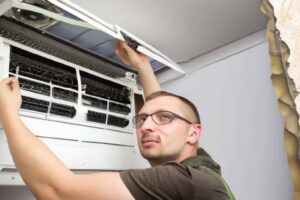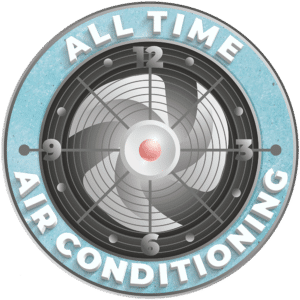Everyone wants to breathe clean air, but the meaning of “clean” differs from person to person. For example, not everyone is sensitive to mold, bacteria, or other indoor allergens. On the other hand, many people are super sensitive to those things.
If that sounds like you, keeping indoor air free from biological contaminants is a major priority. Inhaling invisible allergens simply isn’t good for your health – or your sanity.
Enter ultraviolet (UV) lights! These little fellas live inside your HVAC system and zap the nasty mold and bacteria into oblivion before any of it enters your living space. UV lights can also keep the indoor coil free from fungal growth, which is good since the coil stays wet for several months out of the year.
If you’re considering a UV light for indoor air quality (IAQ), it’s important to know which kind makes the most sense for you. There are actually two different types.
First things first. Get a media filter before installing UV lights.
Before exploring the nitty gritty of UV lights, we’d like to note that UV lights are not your first line of defense against pesky indoor allergens. You’ve really got to capture particulate matter first.
That’s why we recommend installing a media filter in your return ductwork before trying other indoor air quality products. A media filter actually improves the effectiveness of UV lights by capturing tiny particles down to .1 micron in size (or more in the case of some filters). That’s around 700 times as small as a human hair, and it includes mold spores.
Basically, you won’t have to rely on the UV light to destroy every harmful contaminant because the filter has already captured many of them.
Sometimes, these high-quality filters will be all you need. Other “pre-UV light” IAQ solutions include:
- Sealing your ductwork
- Air sealing gaps and cracks between your living area and your attic and/or crawlspace
- Cleaning or replacing your air filter more regularly.
- Testing your whole house to identify – and eliminate – areas with significant air infiltration.
- Taking steps to reduce humidity in your home; high indoor humidity causes dust mites to proliferate and allows mold to grow inside your living space.
The truth is, we don’t always know what it is we’re breathing that’s making us stuffy, sneezy, or prone to headaches. Is it bacteria not being caught by an air filter? Is it spores from mold growing inside the AC system? It’s hard to be sure.
That’s why we recommend starting with a media filter and adding more IAQ products as needed. You might solve your problem just by filtering more particulate matter.
Type 1: UV lights for mold prevention
Your air conditioning system has two coils, one that lives outside and another that lives inside. The indoor coil is located inside your air handler or furnace. It’s dark in there – dark and wet. Water condenses on the coil all throughout the cooling season, so it’s the perfect environment for mold growth.
When mold grows on your indoor coil, the blower fan can blow the mold into your home. Spores enter your living space through the supply vents. During high humidity months, those spores can even proliferate insideyour home. Stopping that process before it starts is a good idea.
Many UV light systems specifically target mold. If you want to minimize (or even eliminate) fungal growth on the AC coil, that’s what you need.
There are various products out there, but we like Honeywell UV systems (pictured at the top of this article). Installed inside your HVAC system, the Honeywell UV lights shine down on your coil, killing bacteria and fungus before it can blow into your home.
Assuming you maintain the equipment, Honeywell guarantees the system for 10 years. Maintenance involves changing the bulbs just once every year or two – that’s it!
Type 2: UV lights for air purification
If anyone in your household has serious allergies or asthma, you might want to take things a step further. Some UV lighting systems are designed to purify indoor air in a comprehensive manner. They consist of a media filter dipped in charcoal and an integrated UV lamp within the filtration apparatus.
Mold spores? Those are definitely gone. But that’s just the beginning. These systems also get rid of odors and chemical vapors while dramatically reducing overall air toxicity.
In other words, they don’t just keep mold off the coil. They’re made to keep mold and bacteria out of your air in every conceivable way.
The one we usually install is the Healthy Climate PureAir system. We install it in much the same way we’d install a media filter. The difference is that the filtration housing also includes the UV light. So you get a MERV 16 filter and mold/bacteria elimination all in one unit.
To be sure, not everyone needs a system this powerful. UV lights on the indoor coil are almost always a good idea, but air purification systems are mostly for people who are really sensitive to biological contaminants.
If you need one of these systems, you probably know it – especially if you’re still uncomfortable after installing UV lights! When properly installed and maintained, these systems can provide substantial allergy and asthma relief.
Choose the UV lighting system that makes the most sense for you! Just don’t forget the order of operations.
UV lights can be a great IAQ upgrade after you install a media filter. Once again, other things you should consider doing before installing UV lights include:
- Sealing your ductwork to prevent circulation of attic or crawlspace air
- Performing a whole-home assessment to see if air is entering your home from unwanted areas, like your attic
- Changing or washing your air filters per manufacturer instructions
- Controlling humidity with variable speed HVAC equipment or a whole-house dehumidifier (assuming it’s already time for an equipment upgrade)
Basically, you want to capture as much particulate matter as possible while also reducing the humidity inside your home. Do those things, and you might solve your IAQ problem without UV lights! And if you do still need UV lights, they won’t have to work as hard to keep your air clean.










Leave a Reply
Your email is safe with us.